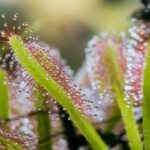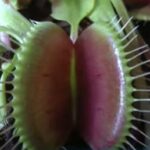As an Amazon Associate, this site earns commissions from qualifying purchases. For more details, click here.
Sundews eat all kinds of small insects, and though not their intention, it does hels keep pests away. But can you use these carnivorous plants to keep fruit flies at bay? Just how effective can sundews be as natural fly controllers? If you want to buy sundews for this purpose, this guide is for you.
Sundews are covered in mucilage, a sticky substance that draws flies and other insects. The mucilage works like flypaper and holds flies down, preventing them from escaping.
How Sundews Draw Fruit Flies
The tentacles of a sundew produce sticky droplets known as mucilage or dew. This substance looks a lot like dew, which is how the plant got its name.
The mucilage has a sweet scent which flies find irresistible. Once the insect tries to eat the dew it gets stuck. The plant then releases digestive enzymes to soften the tissues for easy digestion.
Once its prey has been liquefied, the plant absorbs it. Usually the insect dies before the enzymes are released. The fly expires from suffocation as the mucilage entraps it, or through exhaustion as it tries to escape.
Sundews will keep producing mucilage as long as they are healthy, so if there is no dew, the plant is sick. So make certain the plant receives plenty of nutrients, light and water. Sundews grow well in natural light and indoor grow lights, and of course they must eat at least once a month.
Purified water is ideal for sundews as it does not have any elements that could damage the plant. You can also use natural water such as Poland Spring Water as it is just as good for these pants.
Once the fly is consumed, its nutrients are coursed throughout the plant. This is essentially the process for any insect that sundews catch and eat.
There are many types of sundews you can buy, but all of them have very sensitive tentacles .They can easily detect the presence of flies – or any other potential prey – and take action.
Once a fly falls into the dew, the tentacle rolls over and throws the bug into more tentacles, ensuring it remains trapped.
Some drosera species like d. glanduligera will cover a fly in less than a second. This makes it virtually impossible for a small insect to escape.
Researchers are not sure how sundew tentacles work, but it probably has something to do with chemical stimuli. Mechanical stimulation is also a factor though it is unclear how it functions. Research is currently ongoing however.
Sundews are not poisonous to humans or pets, but flies will suffocate when mucilage engulfs them. This is why sundews are known as flypaper plants because their mechanism is similar.
Why Do Sundews Eat Fruit Flies?
If you want to buy sundews chances are it is not for its flowers, but to watch it catch flies and other insects. But why do sundews to this anyway? Is it necessary for heir survival?
Sundews eat flies, mosquitoes and other insects for their nutritional benefits. Sundews do not need to eat insects to survive, but their nutrients are very important so feeding really helps.
Sundews grow in soils without nitrogen, similar to Venus flytraps. Nitrogen is important for plants so carnivorous plants have to get these somewhere else. And that somewhere are insects like mosquitos, ants, flies etc.
Sundews learned to adapt to their environment. Because there is no nitrogen in the soil, the plants evolved and produced dew to attract insects. How these plants developed these tentacles and the mucilage are unknown, but they clearly show how the plant adapted to its habitat.
Sundews usually feed on mosquitoes, but flies also possess the nutrients sundews need. Once the fly has been consumed, its nutrients are spread throughout the plant.
Sundews use these nutrients to produce mucilage, flower and develop greater resistance to bacterial infection. Insects are not food though. Sundews use photosynthesis to make their own food just like other plants. However that does not make insect nutrients less important. Without nutrition sundews will still live, but they will be weaker.
Depriving sundews of insects will result in lower mucilage production. If the plant is still able to photosynthesize and gets plenty of sunlight, water and air, it will live. But growth will slow so giving insect nutrients to your sundews is a good idea. If your sundews are indoors and ha no access to living bugs, you can feed them Picky Neb Dried Mealworms instead.
Sundews developed traps because nutrients serve an important purpose. So when you see it eating flies, that is a good sign and means the plant is getting the nourishment it needs.
How Many Fruit Flies Can a Sundew Eat?
So now we have established that sundews benefit from insect nutrients, but how much do these plants need? How many should you give?
Sundews typically need 3-4 insects a month. So if your plant has already caught 3 ants this month, it will probably get only one fly.
These numbers are not fixed of course. Some sundews will eat more bugs and others less. But the average is 3-4 a month.
An insect caught in a drosera usually dies in 15 minutes due to suffocation or exhaustion. However, the plant might take a week to digest it. Assuming a digestion period of one week, 4 bugs a month is a good estimate.
If your sundews catch insects on its own, there is no need to keep track of how many it digests. The plant will only attempt to feed when it has the energy available.
If a drosera has already fed and a fly lands in its trap, it will get stuck on the mucilage but the tentacle will make no attempt to eat it. The fly will either escape or die there. However, manually force feeding sundews can be risky to the plant.
Sundews can flower and produce trap at the same time, something Venus flytraps cannot do without losing too much energy. But sundews will not eat if its nutritional needs are already met.
If your sundews are indoors and you are feeding them, take care not to overdo it. Remember that insects, fish food and mealworms are supplementary and their real food is glucose, so light is the priority.
To feed, just drop the food into the mucilage and the plant does the rest. Again you only need to do this once a week and it will be sufficient for the plant. This is applicable to all kinds of sundews regardless of the size.
Why are My Sundews Not Eating?
There are many reasons why sundews will refuse to eat. Here are some suggestions and guidelines to keep in mind.
- Give the plant time to settle. If you just bought a drosera, give it time to get used to your home. It may take a few days or weeks for the plant to acclimatize to the light, humidity, temperature etc. Be patient especially if the plant looks healthy.
- Not enough light. Sundews love light, natural or even indoor grow lights. The minimum is 6 hours, but if the plant is not eating increase light exposure to 12 or even 16 hours. In these instances, direct light is the best option.
- Not enough water. Use the tray method. Put the plant in a container with drainage holes. Place the pot in a tray and fill it with water. For a 10 inch container, pour 3 niches of water. You can add more if it is hot in your area. Add more water as the roots will soak it up.
- The soil has dried out. The soil must always be wet. Dry soil can be fatal to sundews and other carnivorous plants. Do not drench the soil, but it needs to be moist.
- Too many flower stalks. If you want to propagate sundews with flower seeds, you only need one flower stalk. It will give you enough seeds to get started. Cut the rest of the stalk as they will drain the plant’s resources.
- Bacterial infection. Sundews deprived of nutrients will have a hard time fighting off infection. This can rapidly escalate and kill the plant so remove any dead leaves or roots and repot the plant.
- Overfed. If the sundews have already had their fill, it will not eat anymore.
Sundews are not only fascinating to grow, but they are also useful. If you grow fruits and are having trouble with all the fruit flies hanging around, get some sundews and watch the plant take care of these and other pesky bugs.

My fascination with carnivorous plants began many, many years ago with Venus Fly Traps. Now I am more than happy to impart what I know with other enthusiasts and those who are curious about meat eating plants.



